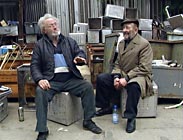
The Love of Scrap Metal and Other Passions
a film by Bernhard Wutka and Thomas Doberitzsch
director, dramaturgy: Bernhard Wutka
camera, editing: Thomas Doberitzsch
sound: Nancy Brandt, Frank Breest, Daniel Ott
sound arrangement: Friedrich Wohlfarth
production manager: Nancy Brandt
producer: 3 Kamele Film
Germany 2003, 80 min, Video, colour
|
|

|
promoted by an initiative of both federal and state institutions "Districts with High Need for Development – the Social City", supported by PROVIDEO GmbH Leipzig and the University of Applied Sciences
Screenings:
Kommunales Kino Leipzig
Cineding Leipzig
UT Connewitz Leipzig
Kino 3001 Hamburg
Clubkino Siegmar Chemnitz
Wurzen
Hannover
|
Dortmund
LUX Kino Halle
La Bim Halle
Werkstattkino München
Brotfabrik Berlin
Kino Mon Ami Weimar
Schrottplatz „Bodo Wachtel“, Leipzig
|
Festivals:
Guangzhou International Documentary Film Festival, China, 2008
Screening formats:
Betacam SP, DVCPro, MiniDV, DVD, S-VHS, VHS
About the film
12 years after the reunification of Germany. Has the Golden Age begun in East Germany? Many people have moved to the West. Of those who stayed, some have made it, some haven´t. The divide also exists within the cities. The outcasts of society and of the new order after the reunification have now retreated into certain districts. They have a reputation for being problem districts with issues like unemployment, crime and right-wing extremism - districts usually avoided or denied by the public. They are said to be the quarters of cheap bargain shops and second-hand shops, and to have a high percentage of foreigners. But are such sweeping statements about the districts justified? Should they not rather be granted the potential for a new, better, beginning? Is it not possible for a new culture and a better community to develop in a place where the rents are low, where there is lots of open green space, and where a variety of different ethnic groups live close together? There are both positive and negative examples for it. Comparable districts can be found in West German cities for historically different reasons, but the situation is similar everywhere.
Film director Berhard Wutka travels weekly between Leipzig and Hamburg and knows the problem well. His attention was drawn to the East Leipzig district when it received money from an aid programme called "Districts with High Need for Development - the Social City". The programme is an initiative of both federal and state institutions and is dedicated to the Leipzig area. Accompanied by his camera man Thomas Doberitzsch, he set out to get an idea of this disreputable district of Leipzig for himself.
The result is a collage of impressions and life-stories, of daily life caught between past and present, that does quite away with the usual stereotypes. Wutka draws the image of an urban space that has been claimed by people for very different reasons who must now come to terms with one another and live the philosophy of living and letting live. There is the owner of an Indian restaurant who opened a Sikh temple in the attic of his house. There is the dealer in scrap metal who, like their Good Shepherd, looks after the scattered individuals scraping a living from collecting scrap metal. There is the professor in physics from Munich who bought an old house and transformed it into an art gallery hotel which has become an attraction for artists from all over Germany. There is the Oriental bar where the air is full with the sweet smell of the hookahs and with the passionate political discussions of the immigrants. There is the boss of a tiny travel agency who resists unfavourable conditions with black humour and sarcastic pluck. Not forgetting all he citizen´s action groups and clubs who fight against the discrimation of their district.
Bernhard Wutka and Thomas Doberitzsch don´t judge, they just watch. After 80 minutes of film, the audience may come to their own conclusions, since naturally, the film never ends. It will be continued in the heads of the audience as well as in the real world.
Presse (German)
Leipziger Volkszeitung
vom 9. Dezember 2002:
„Ihr 80-minütiger Dokfilm ist eine Liebeserklärung an Leipzigs Osten...“ >>
vollständige Kritik
PLAYER das Kinomagazin für Leipzig,
Januar 2003:
„...der Film ist nah dran an den verschiedenen Lebensrealitäten. Was den Osten ausmacht, wird begreifbar anhand der Menschen, die dort wohnen...“ >>
vollständige Kritik
Leipziger Volkszeitung
vom 16. Januar 2003:
„ ‚Die Liebe zum Schrott...‘ ist eine Sammlung von Impressionen und Lebensgeschichten, aus einem Alltag zwischen Vergangenheit und Gegenwart, die nicht so recht beginnen will.“
>>
vollständige Kritik
epd medien
Nr. 13 vom 19. Februar 2003:
„Der Atem, die interessierte Spannung entsteht durch die Geschichten der Leute aus dem Quartier.“ >> vollständige Kritik
die tageszeitung
vom 26. Februar 2003 (Ausgabe Hamburg):
„...Porträt eines Quartiers, das jenseits von Ost-West-Klischees seltsam vertraut erscheint.“ >> vollständige Kritik
Junge Welt vom 29. März 2005:
„Der Sachse als solcher ist nicht unterzukriegen, und wieder einmal wird klar, daß noch die finsterste Ecke in Leipzig sympathischer ist als...“ >>
vollständige Kritik
die tageszeitung vom 25. März 2005 (Ausgabe Berlin):
„...ein älterer Schrottsammler mit Alkoholproblemen, der das deutsche Sozialfürsorgesystem überschwänglich lobt. So was sieht man selten.“ >>
vollständige
Kritik
Background
At first there was the documentation of 52 minutes, called "Ansichten Leipzig-Ost". This documentation was also produced by the programm "Districts with High Need for Development - the Social City" and should portray the East Leipzig district or rather to show the improvements and positive aspects in this district. The documentation, which had its premiere on the 9th November 2001 in the youth centre "Rabet", was celebrated by the audience (about 200 people). Two sold out presentations in the cinema "die naTo" followed.
In the documentary "The Love of Scrap Metal and Other Passions" the director accompanied some characters of this documentation in his further life but he found also some new interesting individuals living in this district.
stills
extract of the film
up
|